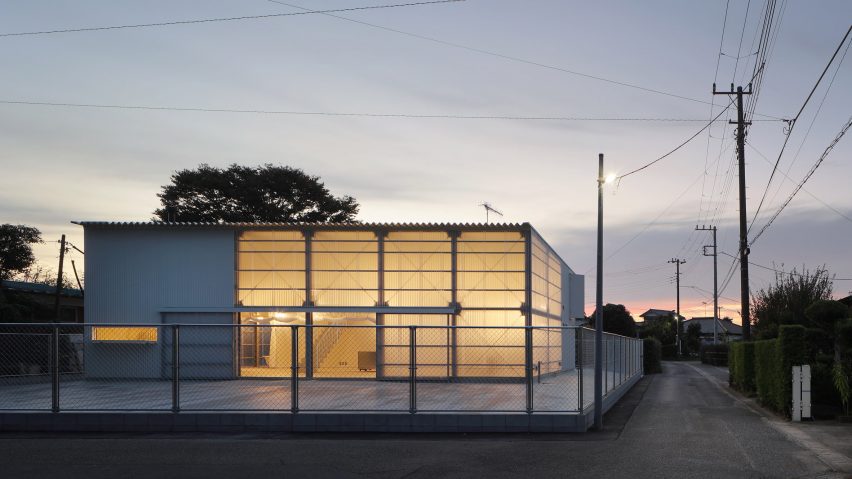Tokyo studio Arii Irie Architects created this warehouse to double as a storage unit and a holiday home for its client in Isumi, Japan.
Named Warehouse Villa, the building is designed by Arii Irie Architects as a "primitive shelter" with a minimal and industrial aesthetic.
After originally planning on purchasing a prefabricated warehouse to hold equipment for his restaurant business, Warehouse Villa's client approached the studio with an "unusual request" to combine a storage unit with living spaces for family and friends.
The resulting project sees roughly a third of the ground floor occupied by a storage unit, wrapped by double-height living spaces and topped by a mezzanine for sleeping.
Rather than differentiate between these functions, the architectural language of a warehouse has been used throughout, with steelwork, corrugated polycarbonate and metal sheets left exposed.
Furniture and fittings are deliberately simple, with a standalone steel kitchen unit in the centre of the ground floor that is flanked by a concrete fireplace and a seating area.
"Our idea was to use the economic, rational and generic language of the warehouse, lightweight metal channels as structure and corrugated metal as skin, for a residential space," studio co-founder Atsuo Arii told Dezeen.
"'Warehouse as house' was an exciting image for us because although it may be brutal, it has a sense of freedom in contrast with the highly commercialised housing industry," added Arii.
A white metal stair leads up to the mezzanine level above the storage unit, offering a more private area that can be used for sleeping.
To open up Warehouse Villa to the yard in summer, Arii Irie Architects added a series of hinged openings, sliding doors and mosquito net curtains to the exterior.
"The reason we designed several types of swinging and sliding doors and windows is to provide ventilation and natural light to this space," said Arii.
"When all the doors and windows are open, the interior feels almost like a covered outdoor space. Therefore, one of the key aspects of the project is a dynamic, changing space behind the seemingly static facade."
The walls of Warehouse Villa are thin and uninsulated, purposefully making the conditions inside highly dependant on the weather outside.
"We see it as a sort of intermediate condition between a tent and a house," explained Arii.
"A building with no insulation may seem irresponsible amidst climate change. However, in this house-warehouse, the consumption of energy is actually very small because there is no air conditioning and there is only minimal artificial lighting," he continued.
"It is dependent upon natural ventilation and natural light, completely connected to the surrounding natural environment," he continued.
While Warehouse Villa was built from scratch, many other warehouses are given a new lease of life as homes with an industrial character, as featured in a previous Dezeen lookbook.
Another project by Arii Irie Architects is a Japanese house extension in Hamamatsu that has angled windows and tilted roofs.
The photography is by Kai Nakamura.

